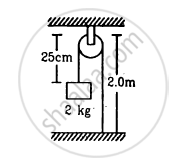Advertisements
Advertisements
Question
A transverse harmonic wave on a string is described by y(x, t) = 3.0 sin (36 t + 0.018 x + π/4)
Where x and y are in cm and t in s. The positive direction of x is from left to right.
(a) Is this a travelling wave or a stationary wave?
If it is travelling, what are the speed and direction of its propagation?
(b) What are its amplitude and frequency?
(c) What is the initial phase at the origin?
(d) What is the least distance between two successive crests in the wave?
Solution 1
(a) Yes; Speed = 20 m/s, Direction = Right to left
(b) 3 cm; 5.73 Hz
(c) `pi/4`
(d) 3.49 m
Explanation:
(a) The equation of a progressive wave travelling from right to left is given by the displacement function:
y (x, t) = a sin (ωt + kx + Φ) … (i)
The given equation is:
`y(x,t) = 3.0 sin (36t + 0.018 x + pi/4)` ...(ii)
On comparing both the equations, we find that equation (ii) represents a travelling wave, propagating from right to left.
Now, using equations (i) and (ii), we can write:
ω = 36 rad/s and k = 0.018 m–1
We know that:
`v = omega/(2pi)` and `lambda = (2pi)/k`
Also
= νλ
`:. v = (omega/2pi) xx ((2pi)/k) = omega/k`
`= 36/0.018 = 2000 "cm/s" = 20 "m/s"`
Hence, the speed of the given travelling wave is 20 m/s.
b) Amplitude of the given wave, a = 3 cm
Frequency of the given wave:
`v =omega/(2pi) = 36/(2xx3.14)= 5.73 "Hz"`
(c) On comparing equations (i) and (ii), we find that the initial phase angle, `phi = pi/4`
(d) The distance between two successive crests or troughs is equal to the wavelength of the wave.
Wavelength is given by the relation: k = `(2pi)/lambda`
`:. lambda = (2pi)/k = (2xx3.14)/(0.018) = 348.89 cm = 3.49 m`
Solution 2
The given equation is y(x,t) = `3.0 sin (36t + 0.018x + pi/4)` , where x and y are in cm and t in s.
a) The equation is the equation of a travelling wave, travelling from right to left (i.e along -ve direction of x because it is an equation of the type )
`y(x,t) = A sin(omegat + kx + phi)`
Here A = 3.0 cm, `omega = 36 "rad s"^(-1)`, k = 0.018 cm and `phi = pi/4`
:. Speed of wave propagation,
`v = omega/k = (36 " rad s"^(-1))/(0.018 cm^(-1)) = (36 "rad s"^(-1))/(0.018 xx 10^2 "ms^(-1)) = 20 ms^(-1)`
b) Amplitude of wave, A = 3.0 cm = 0.03 m
Frequency of wave `v = omega/(2pi) = 36/(2pi) = 5.7` Hz
c) Initial phase at the origin, `phi = pi/4`
d) Least distance between two successive crests in the wave
`= lambda = (2pi)/k = (2pi)/0.018`
= 349 cm = 3.5 m
APPEARS IN
RELATED QUESTIONS
When a transverse wave on a string is reflected from the free end, the phase change produced is ..............
(a) zero rad
(b) ` pi/2 ` rad
(c) `(3pi)/4` rad
(d) `pi` rad
A string of mass 2.50 kg is under a tension of 200 N. The length of the stretched string is 20.0 m. If the transverse jerk is struck at one end of the string, how long does the disturbance take to reach the other end?
Explain why (or how) Solids can support both longitudinal and transverse waves, but only longitudinal waves can propagate in gases
You are walking along a seashore and a mild wind is blowing. Is the motion of air a wave motion?
A transverse wave travels along the Z-axis. The particles of the medium must move
A steel wire of length 64 cm weighs 5 g. If it is stretched by a force of 8 N, what would be the speed of a transverse wave passing on it?
In the arrangement shown in figure , the string has a mass of 4⋅5 g. How much time will it take for a transverse disturbance produced at the floor to reach the pulley? Take g = 10 m s−2.

A transverse wave of amplitude 0⋅50 mm and frequency 100 Hz is produced on a wire stretched to a tension of 100 N. If the wave speed is 100 m s−1, what average power is the source transmitting to the wire?
A 660 Hz tuning fork sets up vibration in a string clamped at both ends. The wave speed for a transverse wave on this string is 220 m s−1 and the string vibrates in three loops. (a) Find the length of the string. (b) If the maximum amplitude of a particle is 0⋅5 cm, write a suitable equation describing the motion.
The phenomenon of beats can take place
